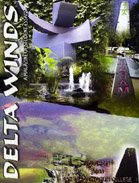Breathing: A Dangerous Habit?
 Delta Winds: A Magazine of Student Essays
Delta Winds: A Magazine of Student Essays
A Publication of San Joaquin Delta College
2000
Breathing: A Dangerous Habit?
Laura Patterson
When did the simple act of breathing become potentially lethal? Every day, millions of American lives are endangered by secondhand smoke. To prevent health risks and improve the lives of nonsmokers, a federal law should be enacted to prohibit smoking in all public buildings, including the workplace.
Studies have shown that secondhand smoke, also known as Environmental Tobacco Smoke, or ETS, seriously endangers the health of nonsmokers, killing 3,000 nonsmokers every year ("Facts"). This is obviously a significant health risk that should not be ignored any longer.
ETS is the combination of two forms of smoke from burning tobacco products: mainstream and side stream smoke. The smoker inhales mainstream smoke. People around the smoker are exposed to mainstream smoke after it is exhaled. Tobacco smoke contains about 4,000 chemicals, 200 known poisons, 60 carcinogenic compounds and 40 proven cancer-causing substances ("Secondhand"). Side stream smoke, which nonsmokers inhale whenever they are around burning tobacco, has a higher concentration of harmful compounds than mainstream smoke. This is because the cigarette's filter and the smoker's lungs absorb some of the toxins as the smoke passes through them. Since side stream smoke comes directly from the burning tobacco, it is unfiltered, so it contains more cancer-causing substances, tar and nicotine, than mainstream smoke. Carbon monoxide, which robs the blood of oxygen, can be up to 15 times higher in side stream smoke than mainstream ("Facts").
When people smoke inside a building, most of the resulting smoke is side stream smoke. Not only does the smoke contain harmful chemicals, "The Surgeon General of the United States reported in 1986 that involuntary smoking can cause cancer in healthy nonsmokers" ("Facts"). Recent studies also indicate ETS smoke causes death from heart disease.
ETS smoke has a particularly bad effect on infants and children who are frequently exposed to it. Studies show that in the first two years of life, babies who are often exposed to smoke have a much higher rate of lung diseases, such as bronchitis and pneumonia, than babies who were rarely or never exposed ("Facts"). ETS exposure is associated with increased respiratory irritation and middle ear infections, as well as upper respiratory tract symptoms in infants and children ("Secondhand"). Smoking should be eliminated from the environment of small children. It should not be allowed in day care centers, nurseries, or other settings where infants and young children are cared for.
The Surgeon General's report of 1986 established that the simple separation of smokers and nonsmokers within the same air space might reduce but not eliminate the risk of exposure to ETS ("Environmental"). In restaurants, only booths that do not completely enclose ETS may separate smoking and nonsmoking sections. Even if there is a separate room for the smokers, there may be a common ventilation system that re-circulates harmful and even deadly chemicals to the lungs of nonsmokers. Due to this extreme health risk, smoking should not be allowed in restaurants, cafes, or any other public building.
In studies of ETS, exposures in the workplace are often greater than exposure at home from spousal smoking. Some options would effectively protect nonsmokers in the workplace. Prohibiting smoking indoors or limiting smoking to rooms that have been specially designed to prevent smoke from escaping to other areas of the building is one option. However, the costs associated with establishing properly designated smoking rooms vary from building to building and are likely to be greater than simply eliminating smoking entirely. ETS exacerbates existing pulmonary symptoms in people with asthma and chronic bronchitis, as well as people with allergic conditions ("Environmental"). Some states require private employers to enact policies that protect employees who do not smoke. This is a step in the right direction, as all smoking inside the workplace should be illegal.
Nonsmokers may also be employed at establishments such as bars, where drinking and smoking seem to go together. If the employees are exposed to ETS night after night, even though they may never smoke directly, they are involuntarily allowing deadly compounds to permeate their healthy lung and heart tissues, leading to death by cancer or heart disease. This is completely unnecessary and could be prevented if the federal government prohibited smoking in bars, clubs and other establishments that serve alcohol. Currently, on the federal level, the General Services Administration issued "Regulations restricting smoking to designated areas only in Federal office buildings" ("Environmental"). In addition, nearly every state has some form of legislation to protect nonsmokers. In 1999, Maine adopted a clean indoor air law banning smoking in restaurants. Arizona and Arkansas adopted laws banning smoking in schools and on school property. This is a positive start, a step in the right direction, but the Federal Government should take the next step and finish what many states have started. The Federal Government should ban smoking in all public establishments to protect innocent children, nonsmokers, and those who simply want to breathe without endangering their lives.
"Facts about Secondhand Smoke." Dec. 1999. American Lung Association. 1
Mar. 2000 "http://www.lungusa.org" http://www.lungusa.org.
"Environmental Tobacco Smoke." Feb. 1995. National Cancer Institute. 1
Mar. 2000 "http://cancernet.nci.nih.gov/index.html"
http://cancernet.nci.nih.gov/index.html.
"Secondhand Smoke." 16 Feb. 1999. United States Environmental Protection
Agency. 1 Mar. 2000 "http://www.epa.gov" http://www.epa.gov.






